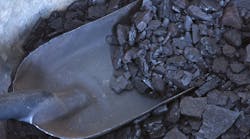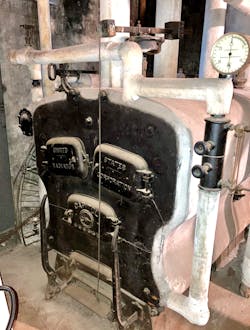Latest from Hydronics
Sponsored
My favorite uncle was my mother’s youngest brother Roger. He brought the sailboat for our two-week vacations on Lake Erie. Our two families would share a large cottage for fun in or on the water. Uncle Roger taught me the basics of sailing his one sail Sunfish. The local kid taught me the excitement of tipping it up on its side and consequently the art of righting the ship when it would tip over completely.
Recently, one of my cousins from my mom’s older brother sent the “Childhood Remembrances of Roger”. Written over two years, it covers his life from earliest memories to high school. It is a great read full of sled riding adventures and home sleeping arrangements. Being the youngest, he slept on a “metal cot that drooped in the middle” for quite a few years.
Hand Fired
The part that I enjoyed the most, being a steam heating geek, was his descriptions of his experience with coal. To really understand the old steam systems, you have to think of them as hand fired with coal rather than automatically fired with oil or gas.
They heated up much slower and therefore had more time to vent the air. Today we over size the venting for better operation. They were sized to bring the house up to temperature from a cold start. Today we can size closer to the heat loss since the system won’t normally be completely off.
I have often wondered about some of the most basic aspects of coal systems, like moving the coal around, storing it, firing it, cleaning up after it and how dirty the air must have been. Uncle Roger explains it all. I hope you enjoy this trip to the past as much as I did. The house had a furnace and not a boiler, but a coal fire is very similar. He was a kid in the 1930s.
Loading the Bin
“At an early age it was my desire to be like my big brother and load the coal bin. The way it worked was that you would call for delivery. They would deliver by dumping the coal in the street. Your job was to load a wheelbarrow with coal and wheel it maybe 30 feet over concrete walks and wood planks laid on the grass and dump it in the window to the coal bin. That was simple enough until the coal bin started to fill up. Then you had to push from the outside or pull from the inside to get the coal away from the window so you could dump more in. A full year of coal was almost up to the rafters (boards would be put on the doorway to the coal bin). At the beginning of the heating season a board would be removed from the bottom and coal extracted. Once you got to the point where you could no longer get coal you would remove another board. In time all the boards would be removed and you would actually enter the coal room to get coal. Needless to say I was thoroughly disenchanted after loading the coal bin one time.
“The operation of the coal furnace was simple in practice. You would bunch up some newspapers and put kindling wood (as I recall dad brought this home with him from work on the traction—it was from scrap boxes from another company in the same building) on top of that. After making sure the flue and the damper were open you lit the newspaper. If all went well the paper caught the wood on fire and then you would add the coal. After the coal was going good you turned the damper down so that the fire did not get too hot. You also made sure the water container on the side of the furnace was full (humidity infusion through evaporation).
Dampers
“At night you would push all the coals to one side, called banking, and turn the damper almost closed. In effect you went to sleep with no heat. It was usually dad who got up first and got the furnace heated up in the morning. If you were lucky, in the morning there were some hot coals that could be used to start the fire again. During the day if you wanted more heat you would open up the damper. This would allow more air to feed the fire. On more than one occasion we would forget to turn the damper back down and a neighbor would come over and tell us that sparks were coming out of the chimney. This was very dangerous, as it could have caught our house or a neighbor’s house on fire. You used a handle to shake the fire grate to dislodge the ashes. They went to a collection area at the bottom of the furnace. Once a day you would shovel them into a container. Needless to say with coal and ashes the basement was very difficult to keep clean.
“For economy, the ashes from the furnace were used to put on the sidewalks when it snowed. Talking about economy, the total ashes from the furnace were contained in a bucket about one-third of a regular size garbage can. The total of the garbage from the house was contained in a can about one half the size of a current size garbage can.
“There was a hill where Whittington Terrace came off Hamilton Ave that the city would close off the street and we would sled ride down it when there was snow. We would also sled ride at the end of the street and on the (Hancy) farm that was located further down in that direction. As all the homes were heated with coal there was considerable smoke and soot. Naturally the soot would settle out onto the ground or snow. Each time it snowed there would be a layer of soot. It was like layered if it snowed more than once before it melted off. I think it snowed more then than it does now.”
Obviously things have changed quite a bit. The air is cleaner, it doesn’t snow as much in Cincinnati, and our heating is much less hands on. I wonder what heating will be like in a hundred years?
Patrick Linhardt is a thirty-nine-year veteran of the wholesale side of the hydronic industry who has been designing and troubleshooting steam and hot water heating systems, pumps and controls on an almost daily basis. An educator and author, he is currently Hydronic Manager at the Corken Steel Products Co.
Patrick Linhardt
Patrick Linhardt is a forty-one-year veteran of the wholesale side of the hydronic industry who has been designing and troubleshooting steam and hot water heating systems, pumps and controls on an almost daily basis. An educator and author, he is currently Hydronic Manager at the Corken Steel Products Co.



